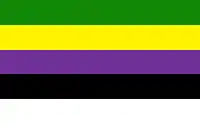| Baoni State | |||||||||
|---|---|---|---|---|---|---|---|---|---|
| Princely State of British India | |||||||||
| 1784–1948 | |||||||||
 Flag
 Coat of arms
| |||||||||
 Baoni State (Kadaura) in the Imperial Gazetteer of India | |||||||||
| Area | |||||||||
• 1901 | 313 km2 (121 sq mi) | ||||||||
| Population | |||||||||
• 1901 | 19,780 | ||||||||
| Government | |||||||||
| • Motto | '"Al hukumu lilah wāl mulk Lilāh" (Rulership and dominion belongs to God) | ||||||||
| History | |||||||||
• Established | 1784 | ||||||||
| 1948 | |||||||||
| |||||||||
| The Imperial Gazetteer of India[1] | |||||||||

Baoni State was a princely state in India during the British Raj. It was a small sanad state, the only Muslim-ruled one in Bundelkhand Agency. Its ruler was granted the right to an 11-gun salute. The Baoni royal family claim to be descendants of the Asaf Jahi dynasty of Hyderabad, tracing its origins to Abu Bakr, the first Islamic caliph.[3]
Baoni was located in the Betwa-Yamuna doab, Uttar Pradesh, with Kadaura as its seat of government. The state was bounded on the north by the district of Cawnpore, in the west by the district of Jalaun and to the south and east by the district of Hamirpur of the United Provinces —as well as a little part in the south-east by Beri State.[4] Baoni had a population of 19,780 inhabitants in 1901, of whom 87% were Hindu and 12% Muslim.[4]
See also
References
- ↑ Hunter, Sir William Wilson; Trübner & Co., London 1885
- ↑ Baoni-Bundelkhand – Fotw
- ↑ Hunter, Sir William Hunter; Cotton, James Sutherland; Burn, Richard; Meyer, William Stevenson (1908). The Imperial Gazetteer of India. Oxford: Great Britain India Office, Clarendon Press.
- 1 2 Imperial Gazetteer of India, v. 6, p. 414.
External links
 Media related to Baoni State at Wikimedia Commons
Media related to Baoni State at Wikimedia Commons- Pictures of Baoni State